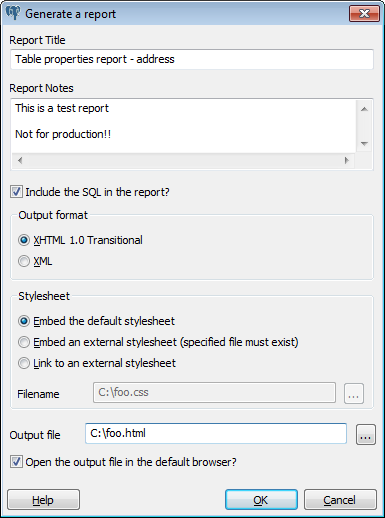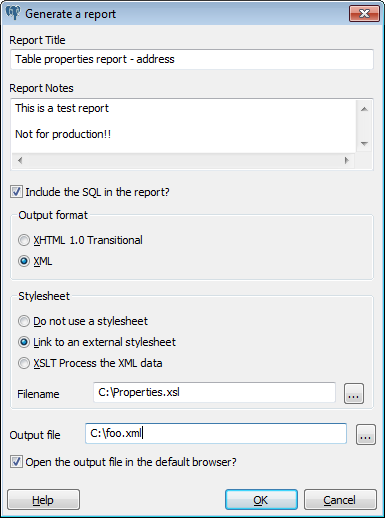Report Tool
pgAdmin includes a simple reporting engine which allows you to quickly generate reports from the queries you write in the Query Tool, or from objects or collections of objects in the main application Window - for example, you can create a report of the properties of any object, or a list of functions in a schema. To create a report, select a node in the browser treeview, and select the report to create from the context menu, or from the Reports submenu of the Tools menu. To create a report in the Query Tool, select the Quick Report option from the File menu.

Each report contains a title and optional notes that can be modified before the report is produced. In addition, you may select whether or not to include any SQL that may be relevant to the report you have selected.
Reports are generated internally in XML, however pgAdmin can apply an XML stylesheet to the report at processing time to format the output as required. A default stylesheet is built-in which produces HTML output. With the HTML output option selected, you can opt to embed the default CSS stylesheet (which will render the report in the same colors as the pgAdmin website), to embed an external stylesheet into the report, or to link to an external stylesheet. The following class/object ID’s are used:
- #ReportHeader: This div contains the report header.
- #ReportNotes: This div contains the option report notes.
- #ReportDetails: This div contains the main body of the report.
- #ReportFooter: This div contains the report footer.
- .ReportSQL: This class is used by the <PRE></PRE> blocks containing SQL.
- .ReportDetailsOddDataRow: This class is applied to the odd numbered rows of tables.
- .ReportDetailsEvenDataRow: This class is applied to the even numbered rows of tables.
- .ReportTableHeaderCell: This class is applied to table header cells.
- .ReportTableValueCell: This class is applied to table data cells.
- .ReportTableInfo: This class is applied to table footnotes.

When generating reports in XML format, you can opt to output plain XML, XML linked to an external XSL stylesheet, or to process the XML using an external stylesheet and save the resulting output. This allows complete flexibility to format reports in any way.
The default XSL stylesheet used to render XHTML output can be used as a starting point for your own, and sample XML data may also be reviewed if required.
Contents: